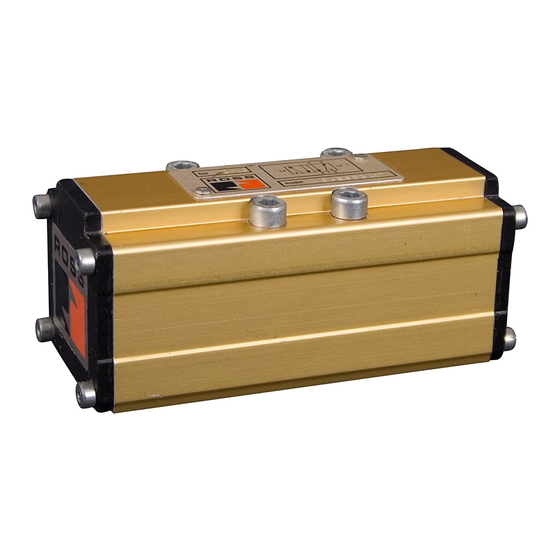
Advertisement
Table of Contents
W60
Thank You!
You have purchased a premium-quality ROSS
It is a stainless-steel spool and sleeve valve built to the highest standards.
With care in its installation and maintenance you can expect it to have a
long and economical service life. So before you go any further, please
take a few minutes to look over the information in this document. Then,
save it for future reference and for the useful service information it contains.
Please read and make sure you understand all installation instructions before proceeding with the installation.
Additional technical documentation is available for download at rosscontrols.com.
If you have any questions about installation or servicing your valve, please contact ROSS or your authorized ROSS
distributor, see contact information listed at the back of this document, or visit rosscontrols.com to find your distributor.
Pneumatic equipment should be installed only by
persons trained and experienced in such installation.
Air Lines: Before installing a valve in a new or an
existing system, the air lines must be blown clean of
all contaminants. It is recommended that an air filter be
installed in the inlet line close to the valve.
Valve Inlet (Port 1): Be sure that the supply line is of
adequate size and does not restrict the air supply because of
a crimp in the line, sharp bends, or a clogged filter element.
Valve Outlets (Ports 2 & 4): For faster pressurizing and
exhausting of the mechanism being operated by the valve,
locate the valve as close as possible to the mechanism.
The lines must be of adequate size and be free of crimps
and sharp bends.
Valve Exhausts (Ports 3 & 5): To reduce exhaust noise
use an efficient silencer. ROSS silencers reduce impact
noise by as much as 25 dB, and produce little back pressure.
Electrical Supply: The voltage and hertz ratings for
solenoid pilot-operated valves are printed on the side of
each solenoid. It is important that
the electrical supply used to power
the valve is equal to these ratings
to avoid possible solenoid burnout.
The electrical connection for such
valves is achieved by means of
a connector whose connections
correspond to the prongs pictured in
the sketch of a typical solenoid pilot.
ROSS CONTROLS
®
ISO 5599-1 Valves
Series
pneumatic valve.
®
VALVE INSTALLATION
If power is supplied by a transformer it must be capable
of handling the inrush current without significant voltage
drop. See Valve Specifications on page 2 for information
on inrush current.
Operating Pressures and Temperatures: Allowable
ranges for pressure and temperatures are given in the
Valve Specifications on page 2. Exceeding the values
shown can shorten valve life.
Pilot Supply:
Pressure Control: For valves with single remote pressure
control, connect the control line to port 14 in the sub-base
or manifold. For valves with double remote pressure
control, connect the control lines to both ports 12 and
14 in the base. See Valve Specifications on page 2 for
required pressures.
Solenoid Control: Pressure for the pilot valves is supplied
from the inlet port. Be sure that port 14 in the base is
plugged or pilot air will escape. If the valve must operate
with an inlet pressure less than the required pilot pressure
(see Valve Specifications on page 2), an external pilot
supply of sufficient pressure must be provided. Connect
the external pilot supply to port 14 in the base.
Vacuum or Non-Air Service: Such applications require
an external pilot supply for solenoid valves. Connect to
port 14 in the base.
Pipe Installation: To install pipe in valve or base ports,
engage pipe one turn, apply pipe thread sealant (tape
not recommended), and tighten pipe. This procedure will
prevent sealant from entering and contaminating the valve.
rosscontrols.com
Advertisement
Table of Contents

Summary of Contents for Ross W60 Series
- Page 1 Additional technical documentation is available for download at rosscontrols.com. If you have any questions about installation or servicing your valve, please contact ROSS or your authorized ROSS distributor, see contact information listed at the back of this document, or visit rosscontrols.com to find your distributor.
- Page 2 (Note that your ROSS valve does not itself require Before inserting the spool-and-sleeve into the valve body, air line lubrication.)
- Page 3 VALVE SERVICE ROSS would be happy to service this valve for you at its factory repair center. If you purchased your valve from ROSS please contact ROSS customer service, if you purchased your valve thru an authorized ROSS distributor please contact the distributor for return instructions.
- Page 4 ROSS’ obligation under this warranty is limited to repair or replacement of the product or refund of the purchase price paid solely at the discretion of ROSS and provided such product is returned to ROSS freight prepaid and upon examination by ROSS is found to be defective.
















Need help?
Do you have a question about the W60 Series and is the answer not in the manual?
Questions and answers